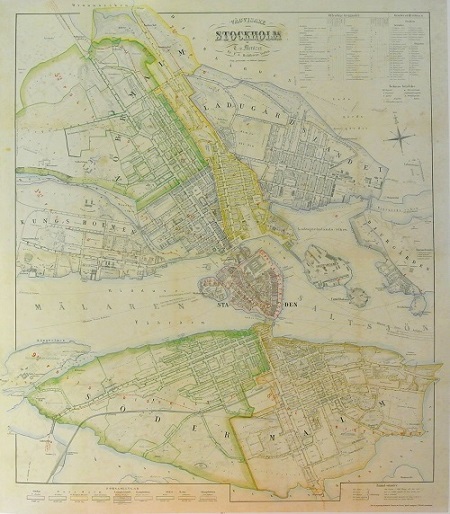1752-ca. 1810. Född och död i Paris.
Fransk geograf. Under åren före den franska revolutionen var han matematiklärare för prinsen av Contis pager. Han gav ut flera atlaser och geografiska verk, varav kan nämnas 'Recherches historiques sur Orléans' (1744). 'Dictionnaire Hydrographique de la France' (1787) och 'Atlas national portatif de la France suivant la nouvelle Division en 83 Départements' (1792). Han lät också ge ut särskilt komplicerade verk i geografiska och historiska ämnen.
Bland arbeten.
Recherches historiques sur Orléans.
Dictionnaire Hydrographique de la France.
Atlas national portatif de la France suivant la nouvelle Division en 83 Départements.
Nouv. biogr. gen.
1606-1665.
Svärfader till Jallott Hubert.
Editor and Enlumineur de la Reine, au bout du Pont Neuf proche les Augustins aux Deux Globes.
Bland arbeten.
Plans et profils de la Ville de Paris. 1650.
Provinces de France et Espagne. 1655.
Carte Générale de l'Isle de France. 1648.
Plan Paris. 1645.
Tooley's Dictionary of Mapmakers.
I vår förra årsbok berättade vi om Frans Lindström och en del andra Stockholmskonstnärer, som var föga kända. Det var egentligen en omarbetning av en liknande artikel i vår årsbok 1951, då Frans Lindström för första gången gjordes känd för allmänheten. På grund av det stora intresset för Lindströms akvareller har emellertid årsboken 1951 sedan flera år tillbaka varit totalt slut. Att vi återigen tar upp detta ämne beror på att vi alldeles nyligen fått bekräftat att Frans Lindström var vår utan jämförelse produktivaste Stockholmsskildrare i bild och att vi fått tillgång till troligen hela hans konstnärliga kvarlåtenskap.
I slutet av förra året fick vi kontakt med Lindströms systerson Folke Fredin och genom honom med Lindströms dotter, fru Dagny Jansson, den enda kvarlevande av Lindströms tre barn. Hon hade i förvar - på sätt och vis utan att riktigt veta om det - faderns många hundra skisser till akvareller och en mängd bildmaterial av olika slag. Då Lindström avled 80-årig 1954 tog sonen Gösta hand om ...
Ur Stockholms borgargilles årsbok 1973.
Stockholm - Mentzer ca 1860.
'Scania vulgo Schonen.' - Valck och Schenk.
DODOENS, REMBERT. [DODONAEUS, REMBERTUS] [DODONAEI, REMBERTI]
Biografiska uppgifter:Mechelen June 29, 1517 – Leyden March 10, 1585
Rembert Dodoens was a Flemish physician and botanist, also known under his Latinized name Rembertus Dodonaeus.
In 1530 he started his studies of medicine, cosmography and geography at the University of Louvain, where he graduated in 1535. He established himself as a physician in Mechelen in 1538. He married Kathelijne De Bruyn(e) in 1539. He had a short stay in Basel (1542-1546). He turned down a chair at the University of Louvain in 1557. He equally turned down an offer to become court physician of emperor Philip II of Spain. He became the court physician of the Austrian emperor Rudolph II in Vienna (1575-1578). He then became professor in medicine at the University of Leiden in 1582.
Dodoens' herbal Cruydeboeck with 715 images (1554) was influenced by that of Leonhart Fuchs. He divided the plant kingdom in six groups. It treated in detail especially the medicinal herbs, which made this work, in the eyes of many, a pharmacopoeia.
It was translated first into French in 1557 by Charles de L'Ecluse ('Histoire des Plantes') and later into Latin in 1583. In his times, it was the most translated book after the Bible. It became a work of worldwide renown, used as a reference book for two centuries.
Dodoens's last book, Stirpium historiae pemptades sex (1583) was the Latin translation of his Cruydeboeck. It was used as a source by John Gerard for his Herball.
Dodoens is commemorated in the plant genus Dodonaea, which was named after him by Carolus Linnaeus.
Bland arbeten:
Herbarium (1533)
Den Nieuwen Herbarius (1543)
Cosmographica in astronomiam et geographiam isagoge (1548)
De frugum historia (1552)
Trium priorum de stirpium historia commentariorum imagines (1553)
Posteriorum trium de stirpium historia commentariorum imagines (1554)
Cruydeboeck (1554)
Physiologices medicinae tabulae (1580)
Medicinalium observationum exempla rara (1581)
Stirpium historiae pemptades sex (1583)
Praxis medica (1616) (posthumous)
Ars medica, ofte ghenees-kunst (1624) (posthumous)



